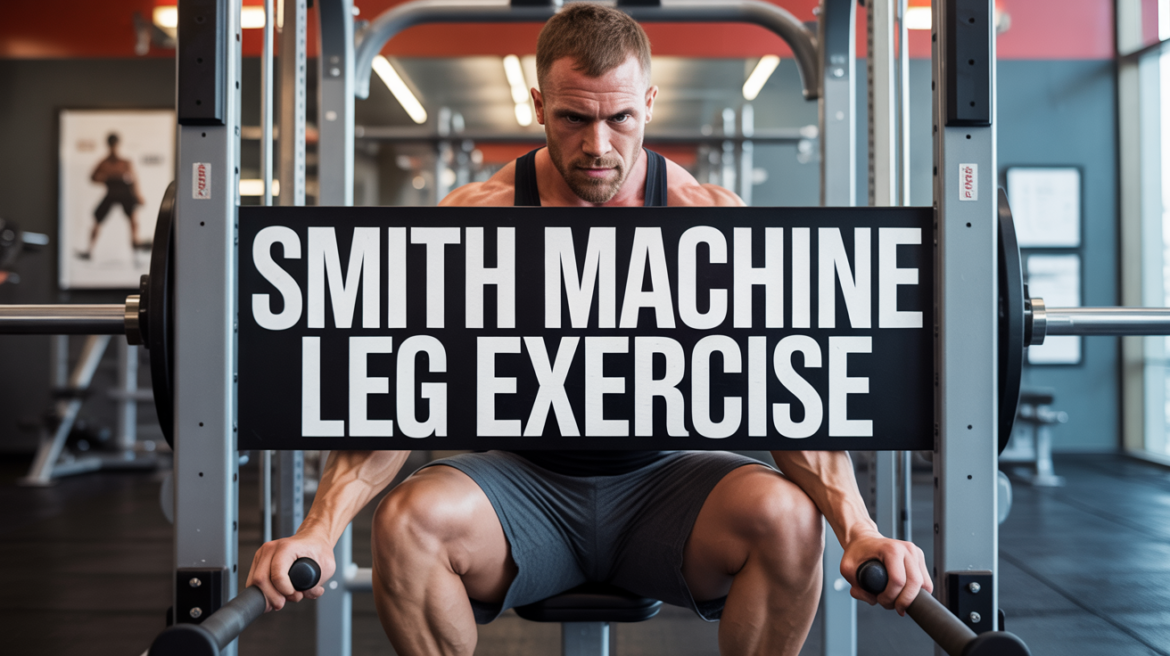Understanding the Smith Machine & Leg Exercise Mechanics
What Is a Smith Machine
The Smith machine is a resistance training apparatus characterized by a fixed barbell attached to vertical guide rails. Its design restricts the bar to a controlled plane of motion, reducing instability that would otherwise be managed by the lifter’s stabilizing musculature. This apparatus is equipped with safety hooks and adjustable stops, which allow the user to limit the range of motion and terminate a set without requiring a spotter.
How Leg Muscles Are Engaged
Lower-body exercises performed on the Smith machine activate the quadriceps, hamstrings, gluteal muscles, and gastrocnemius to varying degrees, depending on the angle of execution and stance width. Unlike free weights, the fixed trajectory reduces demands on deep stabilizers such as the hip abductors and spinal erectors. This alteration in recruitment may allow more precise overload of the prime movers, though at the expense of neuromuscular coordination that free-weight modalities develop.
Key Smith Machine Leg Exercises & Variations
Squat Variations
Smith machine back squats permit vertical loading with reduced stabilizer activation, supporting greater emphasis on quadriceps and glute recruitment. Front squats on the Smith machine adjust the load’s center of gravity anteriorly, shifting the demand toward the quadriceps and core stabilizers while maintaining the guided path.
Deadlift Variants
The Romanian deadlift executed on the Smith machine targets the posterior chain by promoting eccentric loading of the hamstrings while minimizing bar drift. This allows controlled development of hamstring flexibility and strength with reduced risk of bar misalignment.
Lunge / Split-Stance Movements
Reverse lunges and Bulgarian split squats performed with the Smith machine improve unilateral strength and muscular balance. The fixed bar path provides stability, making these exercises particularly useful for hypertrophy when fatigue may compromise form under free-weight conditions.
Hip Thrusts & Glute Emphasis Work
The Smith machine accommodates hip thrust mechanics by allowing consistent bar travel, producing targeted activation of gluteus maximus and posterior chain musculature.
Calf & Lower Leg Isolation
Standing calf raises or seated variations may be executed on the Smith machine, providing direct gastrocnemius and soleus loading under a guided trajectory.
Programming Smith Machine Leg Exercise Routines
Volume, Sets, Reps Guide by Goal
- Strength: 3–6 sets of 4–6 repetitions at ≥75% 1RM
- Hypertrophy: 3–5 sets of 8–12 repetitions at 65–75% 1RM
- Endurance: 2–4 sets of 15–20 repetitions at ≤60% 1RM
Frequency & Rest Intervals
Most evidence supports training legs with Smith machine exercises 1–2 times per week for strength and 2–3 times per week for hypertrophy. Rest intervals of 2–3 minutes (strength) or 60–90 seconds (hypertrophy/endurance) are generally effective.
Warm-Up & Mobility Drills
Dynamic stretches such as leg swings, hip openers, and bodyweight squats improve joint mobility and tissue readiness before loaded Smith machine movements.
Progressive Overload Strategies
Overload may be implemented via incremental weight increases, extended time under tension, or modifications in stance width and tempo.
Benefits & Limitations of Using the Smith Machine for Legs
Advantages
- Guided bar path enhances safety for individuals training without a spotter.
- Reduced stabilization demand permits greater isolation of target muscles.
- Adjustable safety stops support controlled training in hypertrophy phases.
Limitations / Drawbacks
- Diminished activation of stabilizing musculature compared with free weights.
- Fixed trajectory can impose unnatural stress on joints if positioning is incorrect.
- Reduced transferability of strength adaptations to free-weight movements.
Safety, Form & Injury Prevention
Proper Setup & Alignment
Correct bar placement on the trapezius or anterior deltoids, feet positioned to align knees with toes, and maintenance of spinal neutrality are fundamental requirements for safe execution.
Common Mistakes & How to Avoid Them
- Excessive forward knee travel due to poor stance selection
- Hyperextension of lumbar spine during squats or RDLs
- Incomplete range of motion from setting safety stops too high
When to Reduce Load or Modify Movements
Individuals experiencing joint discomfort should decrease load, narrow stance, or substitute partial range techniques.
Considerations for Users with Joint or Back Issues
Those with existing spinal or knee conditions may benefit from controlled partial-range work on the Smith machine, though clinical supervision is recommended.
Sample Workout Plans Using Smith Machine Leg Exercises
Beginner Plan
- Squat (3 × 10)
- Romanian Deadlift (3 × 12)
- Calf Raise (3 × 15)
Intermediate Plan
- Back Squat (4 × 8)
- Bulgarian Split Squat (3 × 10/leg)
- Hip Thrust (3 × 12)
- Standing Calf Raise (3 × 15)
Advanced Plan
- Front Squat (5 × 6)
- Reverse Lunge (4 × 8/leg)
- Romanian Deadlift (4 × 10)
- Hip Thrust (4 × 12)
Scientific Evidence & Best Practices
Electromyography research indicates Smith machine squats activate quadriceps comparably to free-weight squats but with reduced engagement of hip adductors and erector spinae. Strength and conditioning authorities recommend Smith machine use as a supplementary modality rather than a complete replacement for free-weight training. Clinical reviews highlight its application in controlled rehabilitation programs due to predictable mechanics.
FAQs
Can Smith machine leg exercises replace free-weight squats?
No, they should be regarded as supplementary, given their reduced stabilizer recruitment.
Which leg variation best targets glutes vs hamstrings vs quads?
Squats primarily emphasize quads and glutes, RDLs target hamstrings, and hip thrusts isolate glutes.
How often should one train legs with the Smith machine per week?
Two to three sessions weekly are sufficient depending on training status and recovery.
Is the Smith machine safer for individuals with knee or lower back issues?
The guided path offers enhanced control, though improper stance may aggravate joint stress.
What modifications help reduce joint strain?
Adjusting stance width, load reduction, and controlled tempo can mitigate excessive stress.
Is unilateral work beneficial on the Smith machine?
Yes, split squats and lunges address imbalances and enhance muscular symmetry.
How to prevent overuse injuries?
Incorporating variation, adequate rest, and balanced programming with free weights reduces repetitive strain.
Should free-weight and Smith machine training be combined?
Yes, combining both modalities maximizes muscular development and functional strength.

